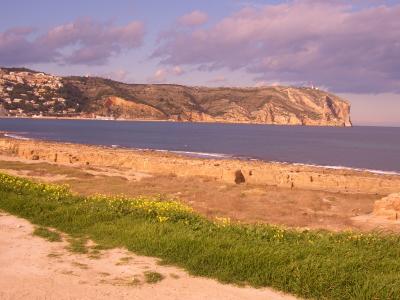Javea, Cabo San Antonio and Tosca Sandstone
The Javea / Xabia beaches of Montañar I between the Arenal sandy beach and the port, and Montañar II between the Arenal and Cala Blanca, consist of areas with natural Tosca sandstone. This is now protected by law, it is no longer possible to cut and remove the sandstone. In fact the Tosca stone which has been traditionally used in Javea and nearby towns for many years ago for building purposes, is now imported from across the sea in Mallorca. The colour of the stone is much lighter than the Javea stone, however just as soft, which makes it easy to work with to make the traditional Tosca stone arches and decorative fascias of many properties found in Javea.
This photo was taken at 15.00h on Wednesday, 14th February, it was cloudy and the wind had a slight chill.

These next images of Javea / Xabia Cabo San Antonio were taken in 15 minute intervals and they show how quickly the climate and scenery can change, clouds were blown out towards the Balearic Islands. The sun’s rays and the warmer land breezes changed the temperature and the outlook of one of Javea’s beautiful landmarks. That’s the great thing about working and living in such a special place. How lucky we all are to live here, then again you make your own luck if you decide to visit or live in Javea….



The following information regarding the Tosca sandstone is taken from the website shown on the link below:
https://en.xabia.org/ver/1833/Tosca-sandstone.html
“The “tosca” sandstone’s golden colour is an essential element of the local architecture and is predominantly present in all the town’s corners, which gives it an ancient monumental touch.
It is a calcareous sandstone which was formed by sand dunes about one hundred thousand years ago. The cut stone still conserves the dune’s stratums (“llavades”) as well as the fissures (“pels”) used by the “arrancadors” (stone quarry workers) as an axis to obtain the basic blocks which were subsequently worked and sculpted. Undoubtedly, the most important sources of the local sandstone “pedreres” (quarries) not only in Xábia, but in the entire Valencian coastline, are the mountain sites: Muntanyars, (the Dalt (high quarry) and the Baix (low quarry). These large quarries were exploited from the Roman Period until 1972 when its extraction was prohibited. Another major quarry site is the Cova Tallada (Sculpted Cave), located at the foot of the cliffs of Cap de Sant Antoni, in whose interior, artefacts from the Andalusian Age have been discovered, which allows us to consider that this quarry had been used since the 12th Century. Currently, these “toscars” (sandstone quarries) constitute a valuable natural heritage, which not only reveal the scenery and climate of the past, but also the techniques and traditional procedures for the extraction of the “tosca” sandstone blocks, an exceptional and essential component of Xàbia’s rich traditional architecture."






